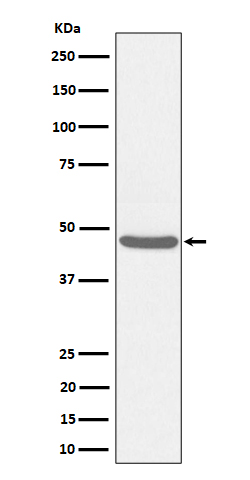Anti-BCKDK Rabbit Monoclonal Antibody
- SPECIFICATION
- CITATIONS
- PROTOCOLS
- BACKGROUND

Application
| WB |
|---|---|
| Primary Accession | O14874 |
| Host | Rabbit |
| Isotype | IgG |
| Reactivity | Rat, Human, Mouse |
| Clonality | Monoclonal |
| Format | Liquid |
| Description | Anti-BCKDK Rabbit Monoclonal Antibody . Tested in WB application. This antibody reacts with Human, Mouse, Rat. |
| Gene ID | 10295 |
|---|---|
| Other Names | Branched-chain alpha-ketoacid dehydrogenase kinase, BCKDH kinase, BCKDHKIN, BDK, 2.7.11.1, [3-methyl-2-oxobutanoate dehydrogenase [lipoamide]] kinase, mitochondrial, 2.7.11.4, BCKDK {ECO:0000303|PubMed:29779826, ECO:0000312|HGNC:HGNC:16902} |
| Calculated MW | 46360 Da |
| Application Details | WB 1:500-1:2000 |
| Contents | Rabbit IgG in phosphate buffered saline, pH 7.4, 150mM NaCl, 0.02% sodium azide and 50% glycerol, 0.4-0.5mg/ml BSA. |
| Clone Names | Clone: 29B01 |
| Immunogen | A synthesized peptide derived from human BCKDK |
| Purification | Affinity-chromatography |
| Storage | Store at -20°C for one year. For short term storage and frequent use, store at 4°C for up to one month. Avoid repeated freeze-thaw cycles. |
| Name | BCKDK {ECO:0000303|PubMed:29779826, ECO:0000312|HGNC:HGNC:16902} |
|---|---|
| Function | Serine/threonine-protein kinase component of macronutrients metabolism. Forms a functional kinase and phosphatase pair with PPM1K, serving as a metabolic regulatory node that coordinates branched-chain amino acids (BCAAs) with glucose and lipid metabolism via two distinct phosphoprotein targets: mitochondrial BCKDHA subunit of the branched- chain alpha-ketoacid dehydrogenase (BCKDH) complex and cytosolic ACLY, a lipogenic enzyme of Krebs cycle (PubMed:24449431, PubMed:29779826, PubMed:37558654). Phosphorylates and inactivates mitochondrial BCKDH complex a multisubunit complex consisting of three multimeric components each involved in different steps of BCAA catabolism: E1 composed of BCKDHA and BCKDHB, E2 core composed of DBT monomers, and E3 composed of DLD monomers. Associates with the E2 component of BCKDH complex and phosphorylates BCKDHA on Ser-337, leading to conformational changes that interrupt substrate channeling between E1 and E2 and inactivates the BCKDH complex (PubMed:29779826, PubMed:37558654). Phosphorylates ACLY on Ser-455 in response to changes in cellular carbohydrate abundance such as occurs during fasting to feeding metabolic transition. Refeeding stimulates MLXIPL/ChREBP transcription factor, leading to increased BCKDK to PPM1K expression ratio, phosphorylation and activation of ACLY that ultimately results in the generation of malonyl-CoA and oxaloacetate immediate substrates of de novo lipogenesis and glucogenesis, respectively (PubMed:29779826). Recognizes phosphosites having SxxE/D canonical motif (PubMed:29779826). |
| Cellular Location | Mitochondrion matrix {ECO:0000250|UniProtKB:Q00972, ECO:0000305|PubMed:24449431} Note=Detected in the cytosolic compartment of liver cells {ECO:0000250|UniProtKB:Q00972} |
| Tissue Location | Ubiquitous. |

Thousands of laboratories across the world have published research that depended on the performance of antibodies from Abcepta to advance their research. Check out links to articles that cite our products in major peer-reviewed journals, organized by research category.
info@abcepta.com, and receive a free "I Love Antibodies" mug.
Provided below are standard protocols that you may find useful for product applications.
If you have used an Abcepta product and would like to share how it has performed, please click on the "Submit Review" button and provide the requested information. Our staff will examine and post your review and contact you if needed.
If you have any additional inquiries please email technical services at tech@abcepta.com.













 Foundational characteristics of cancer include proliferation, angiogenesis, migration, evasion of apoptosis, and cellular immortality. Find key markers for these cellular processes and antibodies to detect them.
Foundational characteristics of cancer include proliferation, angiogenesis, migration, evasion of apoptosis, and cellular immortality. Find key markers for these cellular processes and antibodies to detect them. The SUMOplot™ Analysis Program predicts and scores sumoylation sites in your protein. SUMOylation is a post-translational modification involved in various cellular processes, such as nuclear-cytosolic transport, transcriptional regulation, apoptosis, protein stability, response to stress, and progression through the cell cycle.
The SUMOplot™ Analysis Program predicts and scores sumoylation sites in your protein. SUMOylation is a post-translational modification involved in various cellular processes, such as nuclear-cytosolic transport, transcriptional regulation, apoptosis, protein stability, response to stress, and progression through the cell cycle. The Autophagy Receptor Motif Plotter predicts and scores autophagy receptor binding sites in your protein. Identifying proteins connected to this pathway is critical to understanding the role of autophagy in physiological as well as pathological processes such as development, differentiation, neurodegenerative diseases, stress, infection, and cancer.
The Autophagy Receptor Motif Plotter predicts and scores autophagy receptor binding sites in your protein. Identifying proteins connected to this pathway is critical to understanding the role of autophagy in physiological as well as pathological processes such as development, differentiation, neurodegenerative diseases, stress, infection, and cancer.


